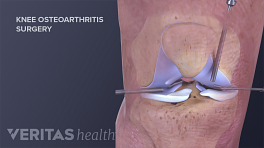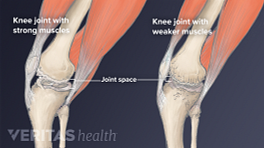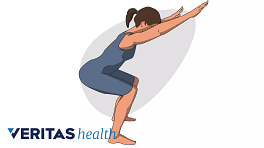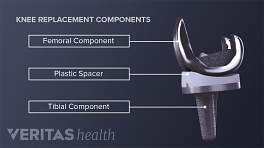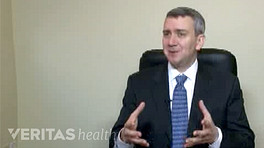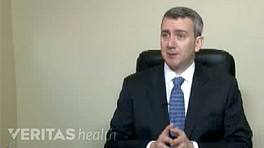Patients who have had knee osteotomy surgery will spend two or more days in the hospital. Because a bone has been intentionally broken, recovering patients will need to spend several weeks on crutches and commit to months of physical therapy or exercise. Patients will have regular follow-up visits with the surgeon’s office to monitor healing. Generally, patients will begin walking unaided 8 to 12 weeks post surgery. A complete recovery can range from 6 months to an entire year. 1 MedLine Plus, US Nat’l Library of Med. / NIH. 2011. "Osteotomy of the Knee." Accessed December 31. http://www.nlm.nih.gov
In This Article:
The timeline for rehabilitation varies significantly depending on the several variables, including:
- The size and location of the wedge of bone that was inserted or removed
- If the surgery was closed wedge (removing bone) or open wedge (inserting bone)
- If an open wedge osteotomy was performed, recovery time may also depend on what type of wedge was inserted. A bone graft from the patient (autograft) may take less time to heal than a bone graft from a donor or an artificial graft.
- The placement and type of hardware used to secure the osteotomy
- The patient’s overall health and ability to heal, possible surgical complications, and other factors
Knee Osteotomy Recovery Goals and Priorities
Regardless of the exact timeline, a knee osteotomy recovery and rehabilitation program focuses on pain control, wound healing, protecting the osteotomy, improving flexibility and range of motion, and building muscle strength.
Pain control. Recovery from knee osteotomy surgery is painful. Pain medication will be given in the hospital and prescribed for after discharge. If at any time pain is not being controlled well with medications, patients should talk to their doctor. Pain is easier to manage when it is addressed in its early stages.
Soft tissue wound healing. While in the hospital, a patient will be taught how to care for the wound once he or she gets home, including changing bandages and bathing. Keeping the wound clean and free of infection is very important.
Reduce swelling and prevent deep vein thrombosis. In the first two weeks following the surgery, steps must be taken to reduce swelling in the knee, avoid blood pooling in the leg veins and prevent Deep Vein Thrombosis (sometimes called DVT). The leg should be elevated, and ice packs may be used intermittently to reduce swelling. Two medical devices may be used: a Cryocuff and/or a Continuous Passive Motion Machine.
Cryocuff. Some patients wear a “cryocuff,” a soft, puffy cast with a Velcro closure that has cold water circulating through it. The cold compression provided by the cryocuff helps reduce swelling. Patients also may be asked to contract and relax the thigh muscles and flex and point the ankle to promote blood flow in the leg.
See When and Why to Apply Cold to an Arthritic Joint
Continuous Passive Motion Machine (CPMM). Attached to a bed, a Continuous Passive Motion Machine is used while the patient is lying on his or her back. This machine keeps the leg elevated and gently moves the leg from a straight to bent position over and over again without the patient’s help. The Continuous Passive Motion Machine can help reduce swelling by keeping the leg elevated, reduce the chance of Deep Vein Thrombosis by keeping the leg moving, and facilitates flexibility and range of motion by forcing repeated bending and flexing.
Protecting the osteotomy. Patients will wear a brace to help protect and support the leg. Bearing too much weight on the leg too soon after surgery could cause the bone at the osteotomy site to shift, upsetting the knee’s newly corrected alignment. Therefore, it is important for patients to carefully follow their doctors’ instructions. Some osteotomy patients are allowed partial weight bearing soon after surgery. Many other patients are told not to bear any weight on the leg for at least 6 weeks, when an x-ray can confirm the osteotomy is healing well.
Patients who are told to avoid weight-bearing activity will use crutches, keeping the affected leg completely off the floor. Once partial weight bearing is permitted, a doctor or physical therapist should give specific instructions about how to use crutches and perform exercises without putting too much weight on the leg.
Improving flexibility and range of motion. The formation of fibrous scar tissue is part of the healing process, but too much scar tissue can impede the knee’s ability to completely straighten and flex. Scar tissue can also feel uncomfortable and lumpy under the skin. Knee stretching and flexing exercises will help prevent the buildup of scar tissue after surgery.
Typically, a doctor will want the patient to be able to be able bend the affected knee to at least a 90-degree angle and fully straighten it within 1 or 2 weeks after surgery. After several weeks of physical therapy, the knee should fully straighten and flex at least 135 degrees.
Building muscle strength. As swelling decreases and the wound heals, priorities will shift to building muscle strength. Physical therapy will include various leg lifts and slowly integrate more challenging partial- and eventually full-weight bearing exercises, such as squats. Likewise, some patients may use a stationary bicycle, initially doing short rides of 5 to 10 minutes without any resistance and gradually building up to longer rides with some resistance.
See physician approved Knee Exercises for Arthritis
While it may be tempting as the leg improves, patients should avoid any exercise that puts stress on the osteotomy wound without first having medical approval. Doing so may jeopardize the knee’s new alignment of the tibia, femur and patella (knee cap).
Most patients will still be using crutches and performing leg-straightening exercises at 8 weeks. It may take 3 to 6 months for osteotomy patients to walk normally and regain full range of motion. It may be 12 months or more before patients can participate in high impact activities, such as jogging.
- 1 MedLine Plus, US Nat’l Library of Med. / NIH. 2011. "Osteotomy of the Knee." Accessed December 31. http://www.nlm.nih.gov


